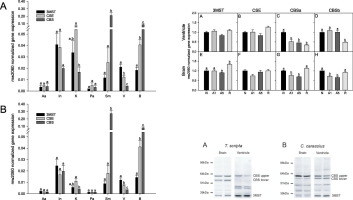当前位置:
X-MOL 学术
›
Comp. Biochem. Physiol. B Biochem. Mol. Biol.
›
论文详情
Our official English website, www.x-mol.net, welcomes your
feedback! (Note: you will need to create a separate account there.)
H2S-producing enzymes in anoxia-tolerant vertebrates: Effects of cold acclimation, anoxia exposure and reoxygenation on gene and protein expression.
Comparative Biochemistry and Physiology B: Biochemistry & Molecular Biology ( IF 1.9 ) Pub Date : 2020-02-24 , DOI: 10.1016/j.cbpb.2020.110430 Arne O Melleby 1 , Guro K Sandvik 2 , Christine S Couturier 3 , Göran E Nilsson 4 , Jonathan A W Stecyk 3
Comparative Biochemistry and Physiology B: Biochemistry & Molecular Biology ( IF 1.9 ) Pub Date : 2020-02-24 , DOI: 10.1016/j.cbpb.2020.110430 Arne O Melleby 1 , Guro K Sandvik 2 , Christine S Couturier 3 , Göran E Nilsson 4 , Jonathan A W Stecyk 3
Affiliation

|
To lend insight into the potential role of the gasotransmitter hydrogen sulfide (H2S) in facilitating anoxia survival of anoxia-tolerant vertebrates, we quantified the gene expression of the primary H2S-synthesizing enzymes, 3-mercaptopyruvate sulfurtransferase (3MST), cystathionine γ-lyase (CSE) and cystathionine β-synthase (CBS), in ventricle and brain of normoxic, anoxic and reoxygenated 21 °C- and 5 °C-acclimated freshwater turtles (Trachemys scripta) and 10 °C-acclimated crucian carp (Carassius carassius). Semi-quantitative Western blotting analysis was also conducted to assess 3MST and CBS protein abundance in ventricle and brain of 5 °C turtles and 10 °C crucian carp subjected to normoxia, anoxia and reoxygenation. We hypothesized that if H2S was advantageous for anoxia survival, expression levels would remain unchanged or be upregulated with anoxia and/or reoxygenation. Indeed, for both species, gene and protein expression were largely maintained with anoxia exposure (24 h, 21 °C; 5 d, 10 °C; 14 d, 5 °C). With reoxygenation, 3MST expression was increased in turtle and crucian carp brain at the protein and gene level, respectively. Additionally, the effect of cold acclimation on gene expression was assessed in several tissues of the turtle. Expression levels were maintained in most tissues, but decreased in others. The maintenance of gene and protein expression of the H2S-producing enzymes with anoxia exposure and the up-regulation of 3MST with reoxygenation suggests that H2S may facilitate anoxic survival of the two champions of vertebrate anoxia survival. The differential effects of cold acclimation on H2S enzyme expression may influence blood flow to different tissues during winter anoxia.
中文翻译:

耐缺氧脊椎动物中产生H2S的酶:冷驯化,缺氧暴露和复氧对基因和蛋白质表达的影响。
为了深入了解气体递质硫化氢(H2S)在促进耐缺氧脊椎动物的缺氧存活中的潜在作用,我们量化了主要H2S合成酶,3-巯基丙酮酸硫转移酶(3MST),胱硫醚γ-裂合酶的基因表达(CSE)和胱硫醚β-合酶(CBS)在常氧,缺氧和复氧的21°C和5°C的淡水龟(Trachemys scripta)和10°C的cru鱼(Carassius carassius)的心室和脑中。还进行了半定量Western印迹分析,以评估5°C的乌龟和10°C的鱼的脑室和大脑中3MST和CBS蛋白的丰度,这些动物经历了常氧,缺氧和复氧。我们假设如果H2S对缺氧生存有利,表达水平将保持不变或因缺氧和/或复氧而上调。实际上,对于这两个物种,基因和蛋白质的表达在缺氧条件下(24 h,21°C; 5 d,10°C; 14 d,5°C)在很大程度上得以维持。通过复氧,在蛋白质和基因水平上,turtle鱼和cru鱼大脑中的3MST表达分别增加。另外,在海龟的一些组织中评估了冷驯化对基因表达的影响。在大多数组织中维持表达水平,但在其他组织中降低表达水平。暴露于缺氧条件下可维持产生H2S的酶的基因和蛋白质表达,而伴随复氧的3MST上调表明H2S可能促进了脊椎动物缺氧生存的两个冠军的缺氧生存。
更新日期:2020-02-25
中文翻译:

耐缺氧脊椎动物中产生H2S的酶:冷驯化,缺氧暴露和复氧对基因和蛋白质表达的影响。
为了深入了解气体递质硫化氢(H2S)在促进耐缺氧脊椎动物的缺氧存活中的潜在作用,我们量化了主要H2S合成酶,3-巯基丙酮酸硫转移酶(3MST),胱硫醚γ-裂合酶的基因表达(CSE)和胱硫醚β-合酶(CBS)在常氧,缺氧和复氧的21°C和5°C的淡水龟(Trachemys scripta)和10°C的cru鱼(Carassius carassius)的心室和脑中。还进行了半定量Western印迹分析,以评估5°C的乌龟和10°C的鱼的脑室和大脑中3MST和CBS蛋白的丰度,这些动物经历了常氧,缺氧和复氧。我们假设如果H2S对缺氧生存有利,表达水平将保持不变或因缺氧和/或复氧而上调。实际上,对于这两个物种,基因和蛋白质的表达在缺氧条件下(24 h,21°C; 5 d,10°C; 14 d,5°C)在很大程度上得以维持。通过复氧,在蛋白质和基因水平上,turtle鱼和cru鱼大脑中的3MST表达分别增加。另外,在海龟的一些组织中评估了冷驯化对基因表达的影响。在大多数组织中维持表达水平,但在其他组织中降低表达水平。暴露于缺氧条件下可维持产生H2S的酶的基因和蛋白质表达,而伴随复氧的3MST上调表明H2S可能促进了脊椎动物缺氧生存的两个冠军的缺氧生存。











































 京公网安备 11010802027423号
京公网安备 11010802027423号